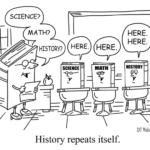From a crowded field of great education journalism, we single out the best of the best for 2018.
By Alexander Russo and Kristen Doerer
Rounding up the best education stories of the year is an annual delight – an early holiday gift featuring 11 amazing pieces of education journalism across nine categories.
This is our third year doing it. But it never gets any easier to whittle down so many impressive pieces of journalism into a manageable list. This year especially required more ruthlessness than we would have liked. There was so much excellent education journalism about important topics like school inequality, inadequate classroom instruction, school safety fears, college completion, federal education policy, and immigration.
As in the past, the emphasis is on journalism that’s compelling, memorable, deeply reported, and nuanced. Some selections have had an immediate, real-world impact. Others have shaped public understanding and generated a conversation that lasted long after they were first published.
So what follows here is a highly opinionated, selective, and in some cases quirky list. (If you want a more inclusive list, check out our “Best Education Journalism of the Week” archive for 2018, which contains tons more great pieces.)
Take a look and let us know what you think. What did we miss? What did we get right?
INEQUALITY
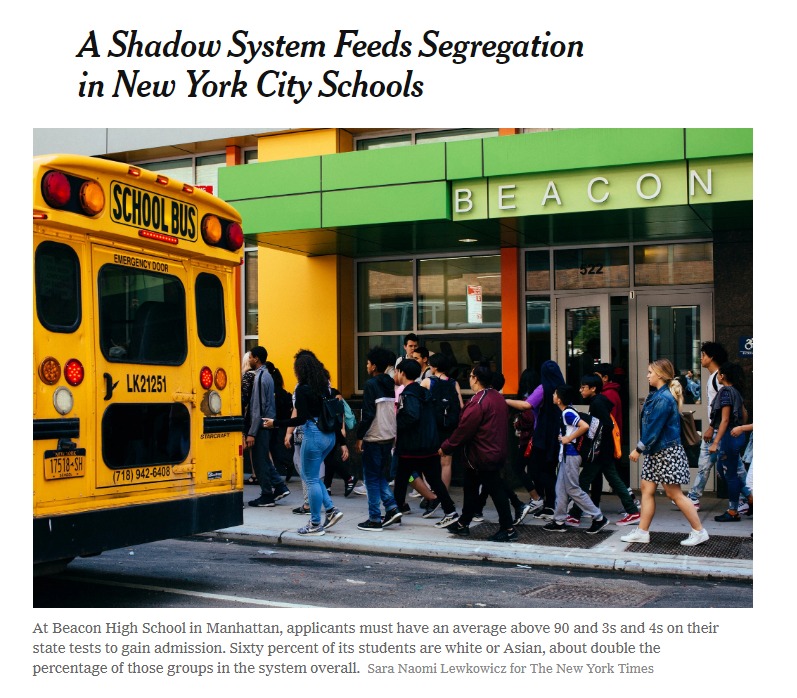
Racially diverse and politically progressive, New York City nonetheless permits many of its middle and high schools to pre-screen students for grades and test scores, systematically excluding African-American and Latino students from the top-scoring schools in the city. That’s what makes Elizabeth Harris and Winnie Hu’s New York Times report, A Shadow System Feeds Segregation in New York City Schools, such a powerful story. It lays bare the scope and depth of a problem that is too easily dismissed as someone else’s concern or fault. Harris and Hu’s scathing examination of how New York City also highlights parents’ voices – too often missing – who express understandable frustration over a system that gives the edge to families that can pay for tutoring or a consultant. With one in five middle and high schools screening students for grades and test scores, write Harris and Hu, “No other city in the country screens students for as many schools as New York.”
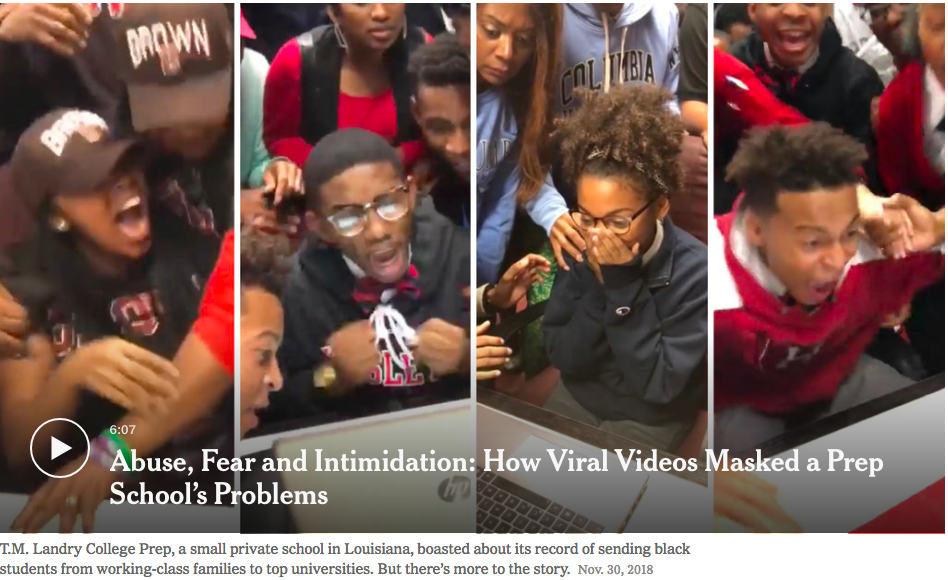
Over the past few years, students from Louisiana’s TM Landry school – many of them African-American – have gained admission to Harvard, Yale, and Princeton. Videos of them opening their acceptance emails have gone viral on social media and been featured on cable news. But the reality of these students’ experiences was much grimmer, as reported in the blockbuster New York Times story, Louisiana School Made Headlines for Sending Black Kids to Elite Colleges. Here’s the Reality. In it, reporters Erica Green and Katie Benner expose the fairy tale story of the school’s magical success. Producing the story required deep reporting and a keen nose for bullshit. The reporters interviewed 46 sources – parents, students, former teachers, and the police – examined incorrect transcripts, college applications, and court documents detailing physical abuse against students. The writing is powerful, and the stories told by parents and students are chilling.
Honorable mentions: Rural Alabama charter opens as first integrated school in Sumter County (Trish Crain for AL.com), Drawing school zones to make classrooms less segregated (Alvin Chang for Vox), Kicked Out (Avi Wolfman-Arent for WHYY Philadelphia), and Charlottesville’s Other Jim Crow Legacy (Erica Green for the New York Times & Annie Waldman for ProPublica).
Further reading: New York Times story exposes school fraud and media credulity
INSIDE THE CLASSROOM
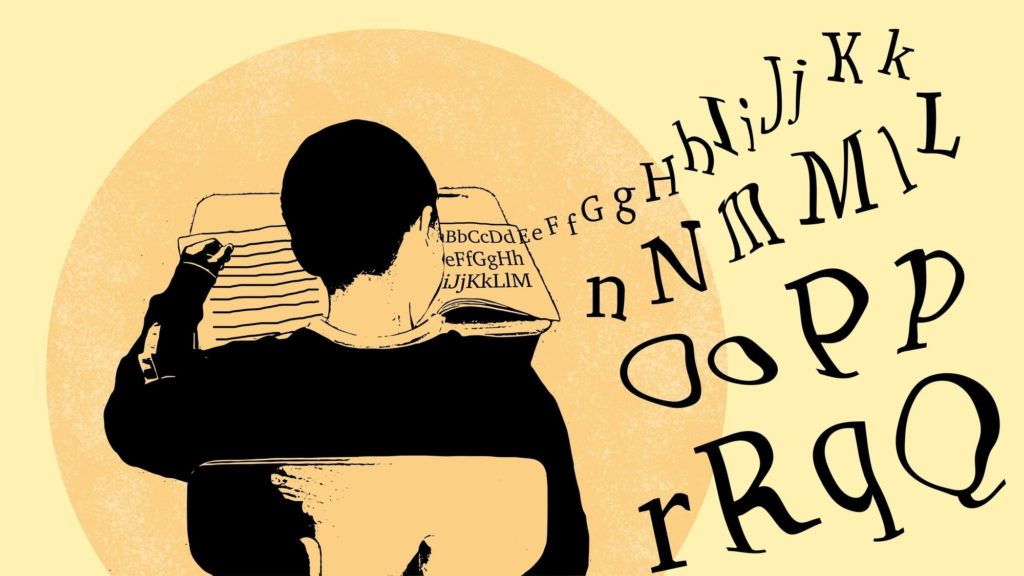
Research shows that teaching kids through explicit instruction in how written language works is a key part of helping them learn to read, but that’s not how most American schools are doing it. The result is a large number of students who are not confident readers — and too many that can’t read at all. This is the tragedy revealed by the APM Reports documentary Hard Words: Why aren’t kids being taught to read? Reported by senior correspondent Emily Hanford, the hour-long segment discusses pedagogy and research but focuses the debate in the stories of memorable characters such as one district official’s efforts to raise students’ reading scores and some education school professors’ resistance to phonics in the University of Mississippi’s teaching program. But the main reason we love Hard Words so much is that it addresses such an important and widespread problem, and has rekindled an important conversation that had gone quiet for too long.
Further reading: Hard reporting: Why reading went under the radar for so long
If you missed it in the deluge of back-to-school stories this fall, Sara Mosle’s New York Times Magazine feature story, Can Good Teaching Be Taught? is well worth going back to read. The story is focused on the educators at an Atlanta elementary school where they are trying to improve student achievement by helping teachers get better at classroom instruction. The characters are carefully drawn. The issues and the stakes are clear. Mosle also provides one of the best recapitulations of the power and the limits of the school reform movement in recent memory: “There was something worse than no reform, it turned out: unsuccessful reform.”
Honorable mentions: Julie Washington’s Quest to Get Schools to Respect African-American English (William Brennan for The Atlantic), What San Diego High School Faculty Learned After a Year of Personalized Learning (Michael Elsen-Rooney for the Hechinger Report), and Age 16 and struggling to read (Adeshina Emmanuel for Chalkbeat Chicago).
SCHOOL SAFETY
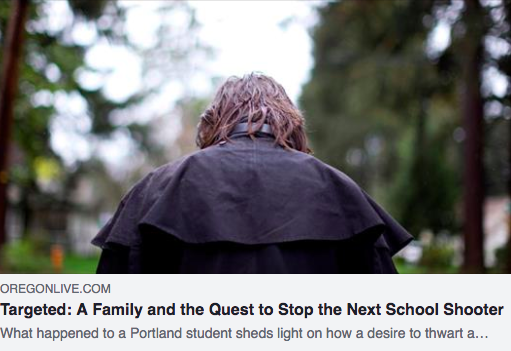
Following a spate of highly publicized incidents, school districts around the country are frantically working to prevent the next school shooting. No surprise that some of their efforts are misguided or excessive. In Bethany Barnes’ masterful narrative, Targeted: A Family and the Quest to Stop the Next School Shooter, school officials suspect a high school student of being a potential school shooter and refer him for further screening. Published in The Oregonian, the story’s opening is chilling: “Like almost every parent who sends a child to a school in America these days, Mark feared the next school shooting.” Barnes’ inside look into the teenage boy’s home is an amazing feat of building trust and humanizing her characters’ experiences.
Honorable mentions: The School Shootings That Weren’t (Anya Kamenetz, Alexis Arnold, and Emily Cardinali for NPR), Inside the $3 Billion School Security Industry (Mark Keierleber for The 74), and School shootings have fueled a $2.7 billion school safety industry (John Woodrow Cox and Steven Rich for the Washington Post).
Further reading: How Bethany Barnes became a star education reporter
THE PARKLAND TRAGEDY

If you’ve been following the aftermath of the Parkland, Florida school shooting, you’ve probably figured out that what happened at Marjory Stoneman Douglas High School that day was tragic not only because of the senseless deaths of so many students and teachers but also because there were so many missed warning signs, procedural fails, and operational meltdowns. And you’ve probably been reading a lot of Scott Travis stories in the Sun Sentinel. There are lots of them. And they’re good. Among the best examples are one piece Travis wrote about how the school district was overconfident about the shooter’s chances of thriving, School officials once predicted Parkland shooter could be ‘model student’, and another about how the school was overly casual about its disciplinary procedures, Schools’ culture of tolerance lets students slide.
Honorable mentions: Parkland shooter always in trouble, never expelled. (Carol Marbin Miller & Kyra Gurney for the Miami Herald), Stoneman Douglas resource officer remains haunted by massacre. (Eli Saslow for the Washington Post), A Broken Trust (Benjamin Herold for EdWeek), and Stoneman Douglas Shooter Was Assigned To Controversial Broward Discipline Program, Officials Now Say (Jessica Bakeman for WLRN).
Further reading: Misleading coverage of school shootings in 2018
SPECIAL EDUCATION
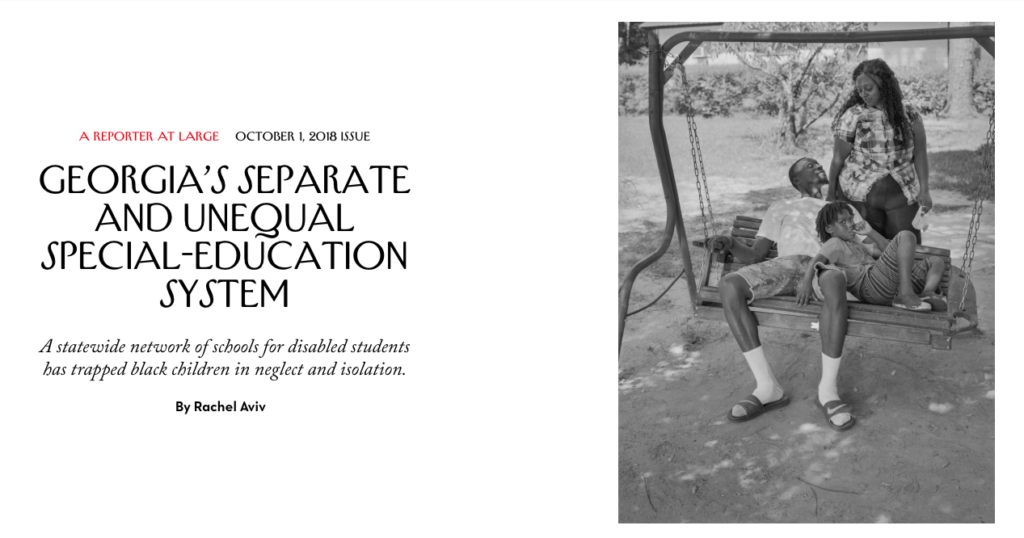
Our schools’ struggle to provide appropriate educational services for students with disabilities is a long and frustrating one, often featuring inadequate resources, under-trained and poorly supervised teachers, low expectations, and racial bias. That’s a big part of what makes Rachel Aviv’s New Yorker story, Georgia’s Separate and Unequal Special-Education System, such a powerful story. Following Seth and his mother Latoya, Aviv exposes a special-education system that keeps kids – disproportionately black boys – with special needs separate from their peers and struggles to provide them with adequate services. But Aviv’s work is more than just an expose. She dives deep into the many challenges Seth and Lotoya face, and the resulting story pulls in the reader and makes you feel for all involved: Seth who is so tortured by the system he starts to introduce himself as “bad”; his mother who is desperately fighting to get him the education he deserves; and the teachers who lacked the support and training needed and treat Seth terribly.
Honorable mentions: For a Teen with Autism, Being Different Was Seen as Being Dangerous (David Desroches for Connecticut Public Radio), and Back of the Class (Susannah Frame and Taylor Mirfendereski for KING5).
Further reading: From cheating scandals to broken schools, how New Yorker writer Rachel Aviv tells education stories
STUDENT MOBILITY

It’s increasingly well-known that student mobility among different schools makes success harder for both teachers and students. And there were several great looks at the impact of housing instability and student transience in 2018. But the best among them was Lessons Lost, the Milwaukee Journal Sentinel series by Erin Richards that showed how few students have enough stability in their lives to attend the same school for multiple years. The problem is probably more dramatic than most of us imagine. In one school, only eight of the 47 third graders remained by eighth grade, creating enormous continuity and engagement challenges. The series also features a national overview showing that half the states don’t track or post data on student transience. And those states that do track numbers do so differently, making comparisons all but impossible.
Honorable mentions: The children of 8B: One classroom, 31 journeys, and the reason it’s so hard to fix Detroit’s schools (Erin Einhorn for Chalkbeat Detroit), Reading, Writing, Evicted (Bethany Barnes for The Oregonian), How Neighborhoods Shape Children for Life (Emily Badger and Quatrong Bui for the New York Times), and Putting Puerto Rico’s Schools Back on Track (Andrew Ujifusa for EdWeek).
THE YEAR OF THE TEACHER
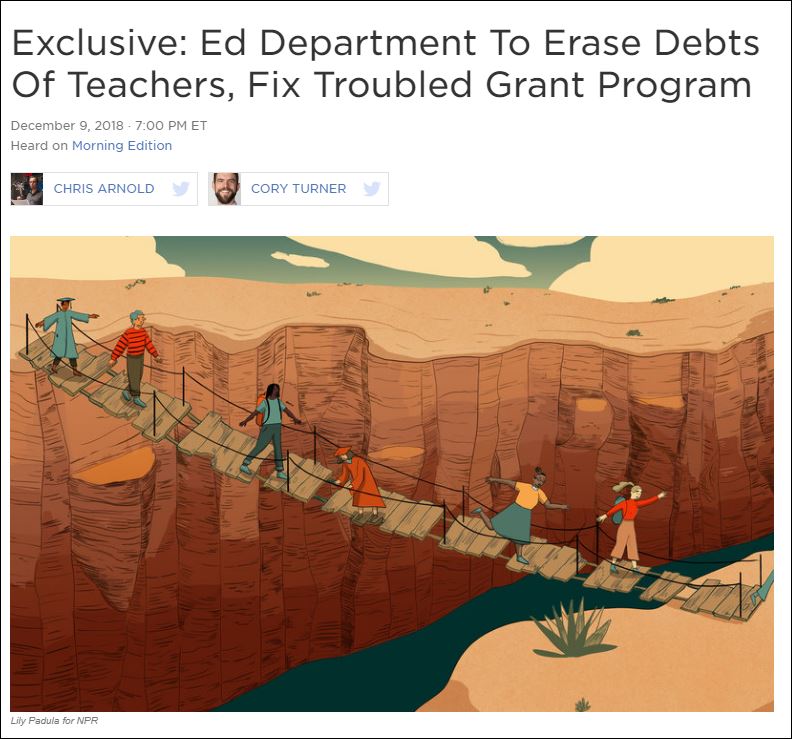
The U. S. Department of Education’s troubled TEACH Grant program has been converting grants intended to encourage teachers who work in high-need areas into loans that teachers have to pay back. NPR reporter and editor Cory Turner spent much of the past year uncovering this story, with Chris Arnold and others. Their coverage led 19 U.S. senators to send a letter to DeVos calling for immediate action and resulted in renewed promises from the USDE to help those teachers wrongly hit with unexpected debts. Thoughtful, nose-to-the-grindstone reporting can make a real difference. Read the entire series here: The Trouble with TEACH Grants.
Honorable mentions: Midterms test the durability of the teacher uprising (Moriah Balingit for the Washington Post), Fighting Poverty, Drugs, and Even Violence, All on a Teacher’s Salary (Dana Goldstein for the NYT), and An Addict Dies in a School Restroom. He Was a Teacher. (Michael Wilson for the New York Times).
EDUCATING IMMIGRANT, REFUGEE, and ELL STUDENTS

A Betrayal, published in New York Magazine and ProPublica, is an enthralling and heart-wrenching story about a teenage boy who escaped MS-13 in El Salvador only to be pulled back into the violent gang in a Long Island high school. In the U.S., the teen makes a deal with the police and begins informing on the gang with the expectation the police would help him get out of it. Instead, ICE begins a deportation case against him, jailing him alongside those he informed on. And the school system played a role. Hannah Dreier spent months navigating a school wary of press coverage, gaining the trust of her sources, and examining hundreds of messages. She then tied her subject’s suspenseful story to a broader one on immigration in the US, ICE, and school policy.
Honorable mentions: In a Migrant Shelter Classroom, ‘It’s Always Like the First Day of School’ (Dana Goldstein and Manny Fernandez for the NYT), Education for immigrants: One person’s journey to enroll in higher education (Mike Elsen-Rooney for the Indianapolis Star), and Turning rampant anti-Muslim bullying into teachable moments (Leila Fadel for NPR).
Further reading: Not just any high school story: How a ProPublica immigration reporter profiled a Long Island high school student trying to get out of MS-13
HIGHER EDUCATION
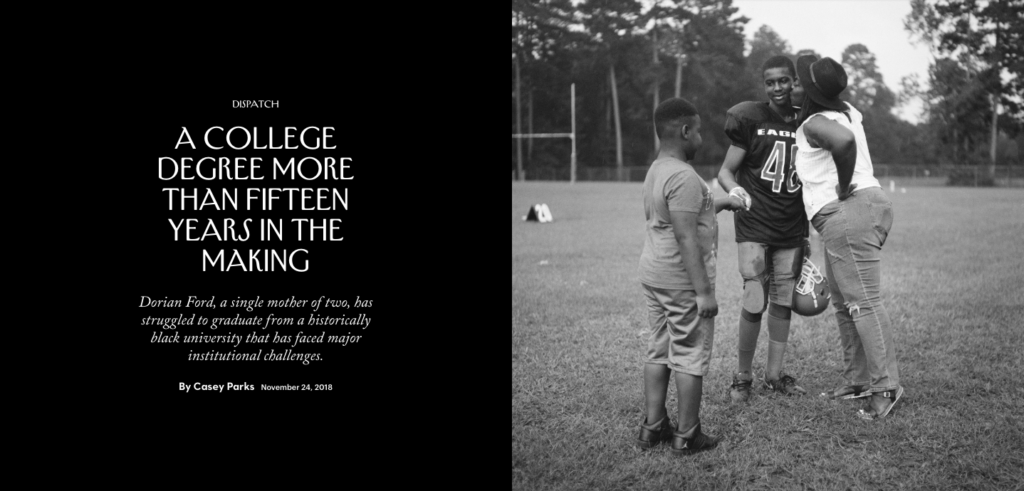
The story of Historically Black Colleges and Universities (HBCUs) is full of students with big dreams but many obstacles, including among them the pathetic under-funding of the schools themselves. Casey Parks’ New Yorker feature story, A College Degree from an H.B.C.U., More than Fifteen Years in the Making, explores these issues through the experiences of Dorian Ford, a young mother from Louisiana who graduates high school underprepared for college-level work and then struggles mightily to take and pass classes while also raising two boys. Her challenges – among them finding working internet and the time to write papers – are interspersed with the long story of how the HBCU she attends, Grambling State, was historically starved of funding by the state. It’s an amazing read, even if you think you don’t care much about anything that’s not strictly about the K-12 system.
Honorable mentions: They Wanted Desegregation. They Settled for Money, and It’s About to Run Out (Adam Harris for The Chronicle of Higher Education), Education for All… Even a ‘Nazi’? (Greg Toppo for Inside Higher Ed), and Meet the New Mega-University (Goldie Blumenstyk for the Chronicle of Higher Education).
Further reading: Widening the lens: What makes Casey Parks’ New Yorker story so good
That’s our list. Think you can do better? Show us what you got.
Related posts
Best education journalism of 2017
Best education journalism of 2016
Coming in January: Predictions and story recommendations for the new year, favorite bylines and outlets, and best practices for education journalists.
ABOUT THE AUTHORS

Alexander Russo
Alexander Russo is founder and editor of The Grade, an award-winning effort to help improve media coverage of education issues. He’s also a Spencer Education Journalism Fellowship winner and a book author. You can reach him at @alexanderrusso.
Visit their website at: https://the-grade.org/













